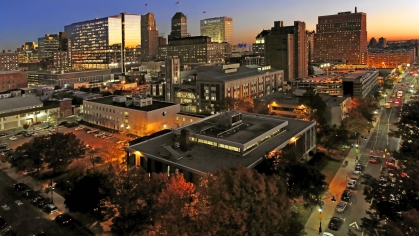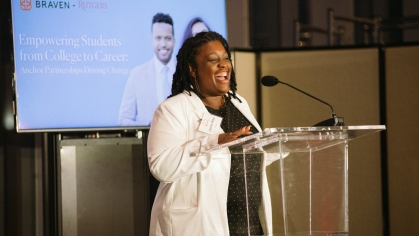At Rutgers University-Newark, Change Is Everywhere
More than 300 students are now living at 15 Washington Street following its long-awaited renovation. Major steps have been taken to make the honors living-learning community a reality. Shuttle bus service has been enhanced, and high speed Wi-Fi is virtually everywhere.
Returning to classrooms, residence halls and dining facilities this fall, faculty and students were struck by the massive physical and cosmetic changes across the 38 acres comprising Rutgers University-Newark in just a few months.
Much more change to improve the university experience is coming.
“When we did our strategic planning a little more than a year ago, we agreed that a high priority for us was to invest in the spaces and places where we live, learn, create and engage the world,” says RU-N Chancellor Nancy Cantor. “With input and participation from across Rutgers-Newark, we are doing just that and in ways big and small, all over our physical campus and the adjoining streets and spaces.”
The strategic-planning process is a source of pride for the Rutgers community, according to Peter Englot, RU–N senior vice chancellor for public affairs. University leaders conducted a number of intensive town halls, tightly organized meetings and less formal sessions with students, faculty and staff over a seven-month period last year to understand precisely how to enhance student life.
“This is not any one individual’s plan,” Englot said. “We gathered a lot of input and one of the key needs we heard was to improve the physical environment so that it is worthy of our students, faculty and staff. We learned we needed to improve the aesthetics and infrastructure.”
The massive $85 million overhaul of 17-story 15 Washington Street, the previous home of the law school and earlier the American Insurance Company headquarters, is perhaps the most noticeable physical change to the footprint. A total of 211,000 square feet of housing have been added in modern one- to four-bedroom units, with an additional 52,000 square feet allotted for Cantor’s living quarters and residence hall staff.
Rutgers-Newark’s four residence halls – 1,500 of the 11,600 students are residents, while the balance commute – have been equipped with high-speed internet service, and 700 new internet access points are located throughout the university’s 33-building downtown complex.
As one of many benefits of its strategic alliances with the city of Newark and Military Park Partnership, RU–Newark achieved what is believed to be the fastest outdoor Wi-Fi service in the country, ranging from 100 to 600 megabytes per second, as it was studying how to upgrade service.
A major initiative under way is the development of a residential honors living-learning community that ultimately will bring together 500 students identified for academic promise through an expansive process, providing opportunities for them to excel on- and off-campus. Thirty students are now enrolled in the social justice learning community, the first group of what will evolve into honors living-learning cohorts of 125.
The buildout of the multipurpose Express Newark – what campus leaders describe as a “university-community collabratory” – on the site of the former Hahne & Company department store is continuing. The space is being designed as an arts incubator, to encourage cross-cultural projects, nurture creativity and engage a highly diverse community outside of the university.
Construction projects have been approved that recognize the needs of the large student commuter population and the value of alumni relationships. A commuter hub is planned, to give nonresident students space to study or socialize between classes, and an iconic former mansion downtown has been acquired for use as an alumni house, encouraging RU-N graduates’ continuing interaction with the university community.
Englot notes that the foundation of the strategic plan was to identify broad priorities, leaving room to adapt plans nimbly and improvise as new opportunities arise. Approximately $2 million alone was spent on basic upgrades, including more highly functional classroom furniture, fresh paint, enhanced electrical capacity, audio-visual equipment and computer hardware and software.
“Not to be overlooked are the simple changes we’ve made,” said Englot, “such as improving the ambience of learning environments with new chairs and desks that facilitate more flexible classroom configurations to improve instruction, and the new locker system for receiving packages in the residence halls. Both are receiving lots of buzz.”
---------------------------------------------------------------------------------------------------------------------------
Photo Credit: Mahirah Syed

